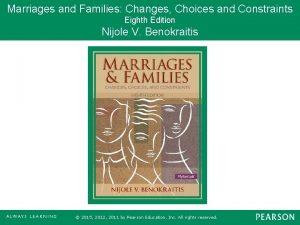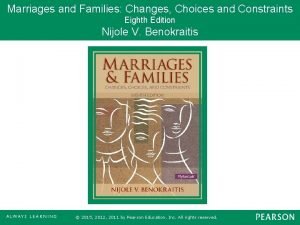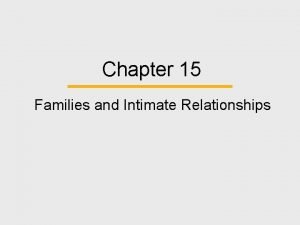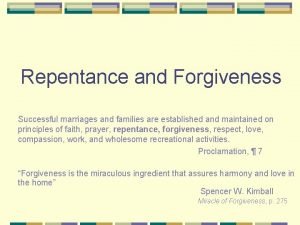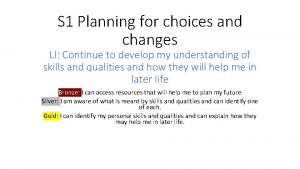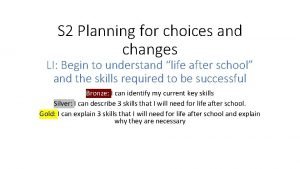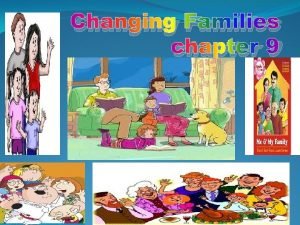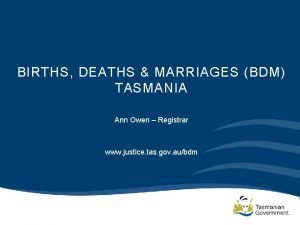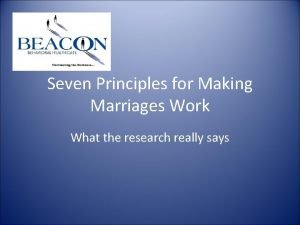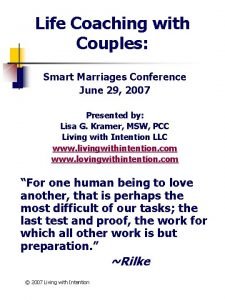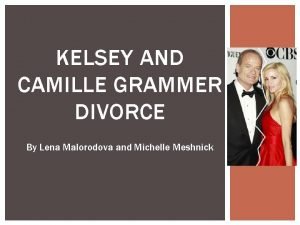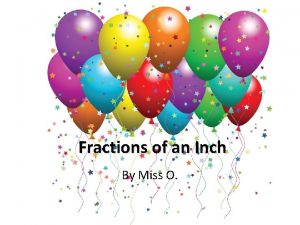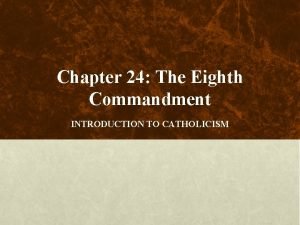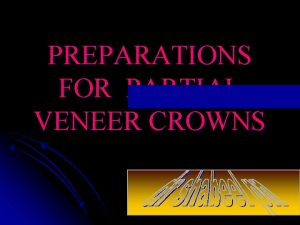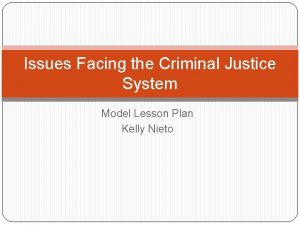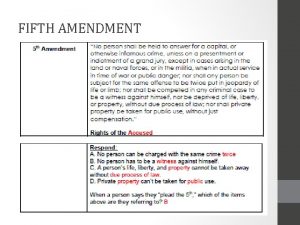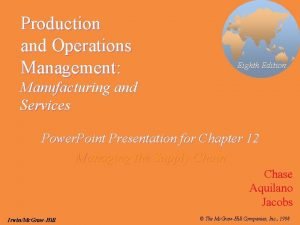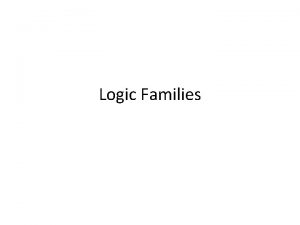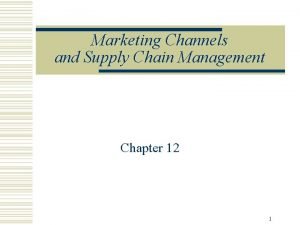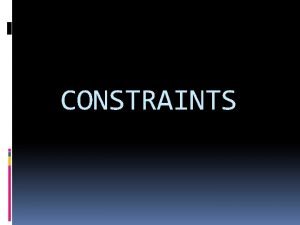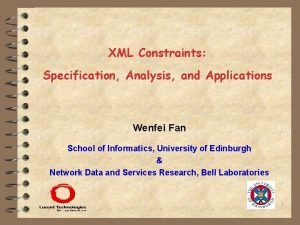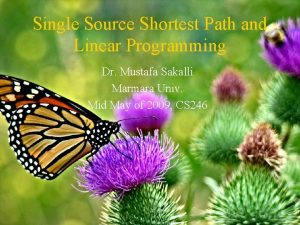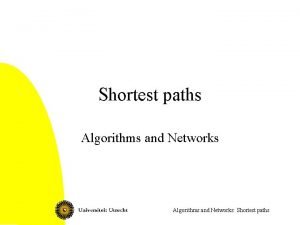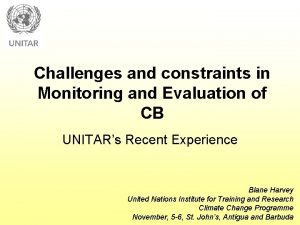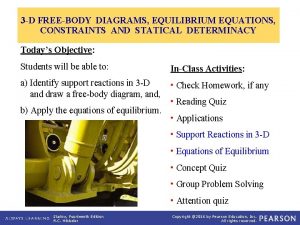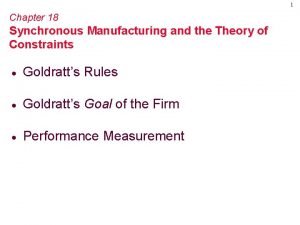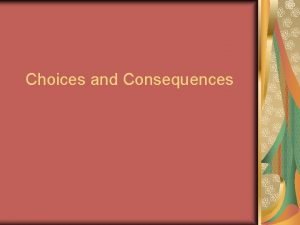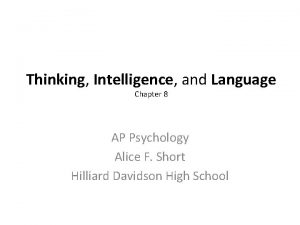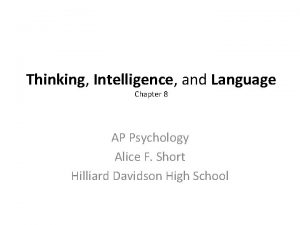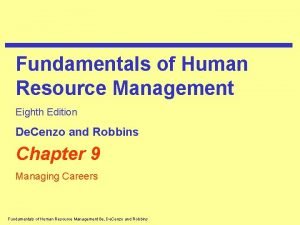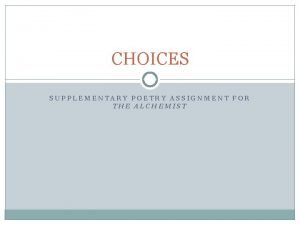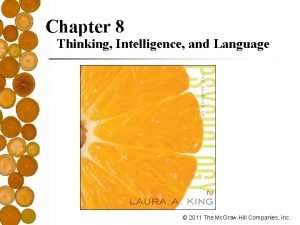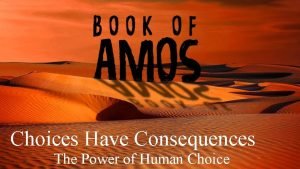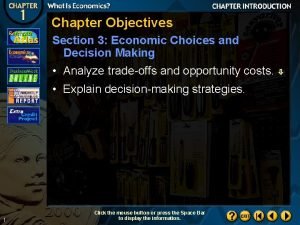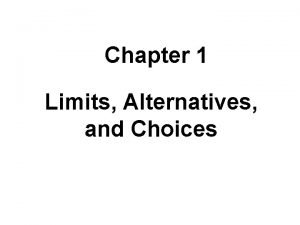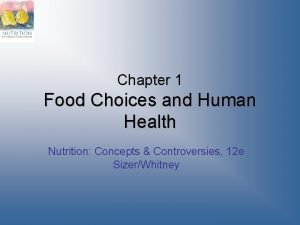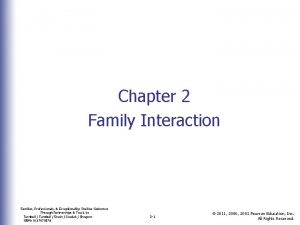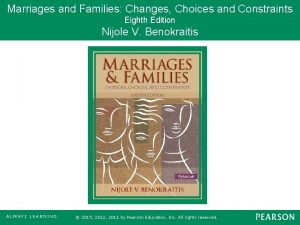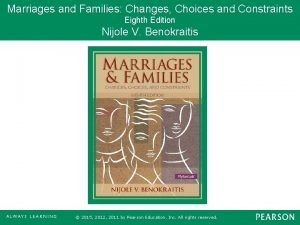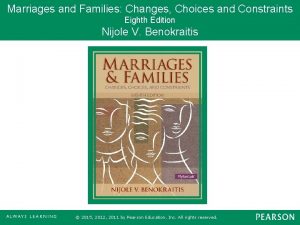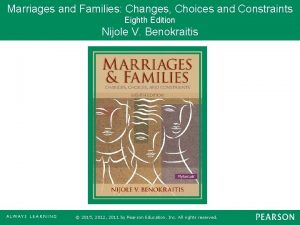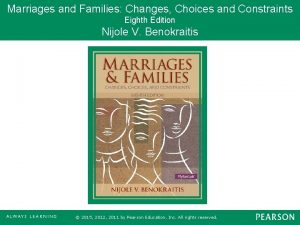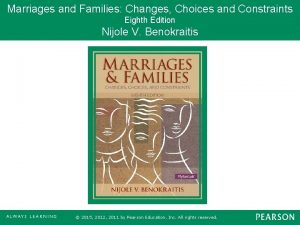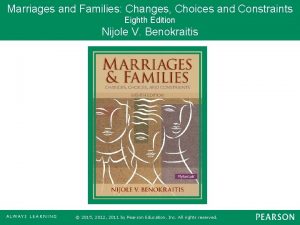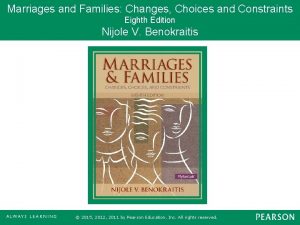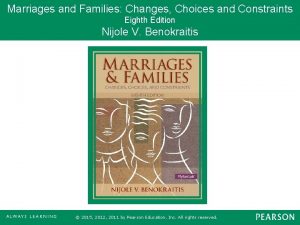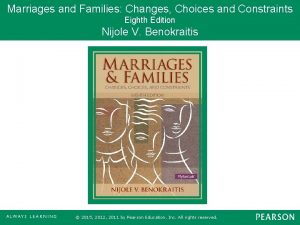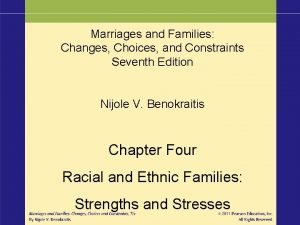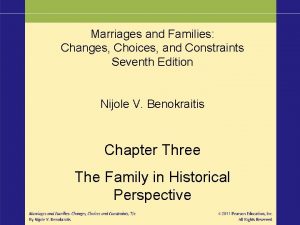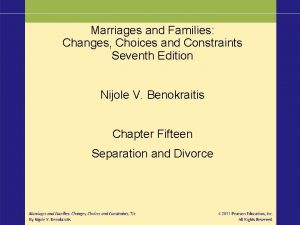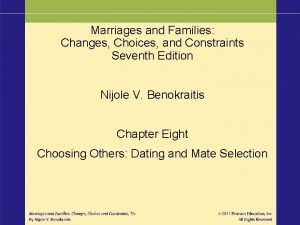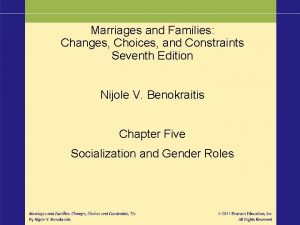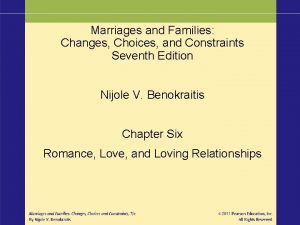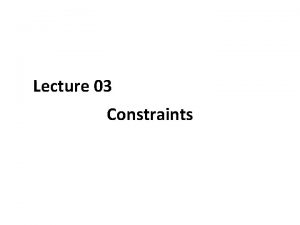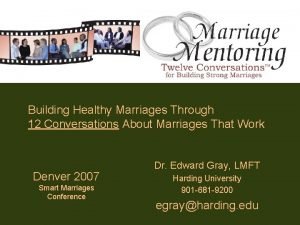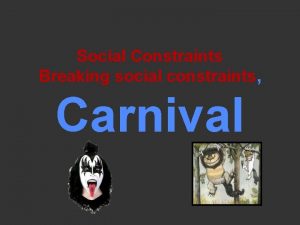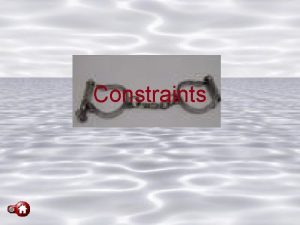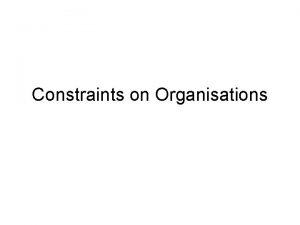Marriages and Families Changes Choices and Constraints Eighth





















































- Slides: 53

Marriages and Families: Changes, Choices and Constraints Eighth Edition Nijole V. Benokraitis © 2015, 2012, 2011 by Pearson Education, Inc. All rights reserved.

Chapter 2 STUDYING THE FAMILY Marriages and Families: Changes, Choices and Constraints, 8 e © 2015, 2012, 2011 by Pearson Education, Inc. All rights reserved.

Learning Objectives LO 2. 1 Describe three ways that theory and research can help people make better decisions about their families LO 2. 2 Describe eight major family theoretical perspectives, identify whether each is macro- and/or micro -level, and summarize the strengths and limitations of each perspective Marriages and Families: Changes, Choices and Constraints, 8 e © 2015, 2012, 2011 by Pearson Education, Inc. All rights reserved.

Learning Objectives LO 2. 3 Describe seven data collection methods that researchers use to study families and identify each of the method’s strengths and limitations Marriages and Families: Changes, Choices and Constraints, 8 e © 2015, 2012, 2011 by Pearson Education, Inc. All rights reserved.

Learning Objectives LO 2. 4 Describe the ethical standards that researchers must follow, and explain the political, religious, and community constraints that researchers encounter Marriages and Families: Changes, Choices and Constraints, 8 e © 2015, 2012, 2011 by Pearson Education, Inc. All rights reserved.

Why We Should Study the Family • What we don’t know can hurt us • Theories and research help us understand ourselves and our families • Theories and research help us make informed decisions Marriages and Families: Changes, Choices and Constraints, 8 e © 2015, 2012, 2011 by Pearson Education, Inc. All rights reserved.

What We Don’t Know Can Hurt Us • Reliance on TV shows and internet for information is dangerous – Perpetuates misleading and incorrect information Marriages and Families: Changes, Choices and Constraints, 8 e © 2015, 2012, 2011 by Pearson Education, Inc. All rights reserved.

Theories and Research Help Us Understand Ourselves and Our Families • Theories and research: – Outline numerous aspects of family life – Provide a view taking into consideration various factors Marriages and Families: Changes, Choices and Constraints, 8 e © 2015, 2012, 2011 by Pearson Education, Inc. All rights reserved.

Importance of Sociological Theory • In this video George Ritzer discusses the importance of Sociological theory to an understanding of society and social behavior http: //abavtooldev. pearsoncmg. com/sbx_videoplay er_v 2/simpleviewer. php? project. ID=MSoc. L&clip. ID= Ritzer_01_63. flv Marriages and Families: Changes, Choices and Constraints, 8 e © 2015, 2012, 2011 by Pearson Education, Inc. All rights reserved.

Theories and Research Help Us Make Informed Decisions • Research: – Helps make informed decisions – Enhances the ability to think critically before making a decision Marriages and Families: Changes, Choices and Constraints, 8 e © 2015, 2012, 2011 by Pearson Education, Inc. All rights reserved.

Experiments • This video explains the role of experiments in theories and research http: //abavtooldev. pearsoncmg. com/sbx_videoplay er_v 2/simpleviewer. php? project. ID=MSoc. L&clip. ID= explain_exp_method_768 K. flv Marriages and Families: Changes, Choices and Constraints, 8 e © 2015, 2012, 2011 by Pearson Education, Inc. All rights reserved.

Theoretical Perspectives on Families • • • The structural functional perspective The conflict perspective Feminist perspectives The ecological perspective The family development perspective Marriages and Families: Changes, Choices and Constraints, 8 e © 2015, 2012, 2011 by Pearson Education, Inc. All rights reserved.

Theoretical Perspectives on Families • • The symbolic interaction perspective The social exchange perspective The family systems perspective Combining theories Marriages and Families: Changes, Choices and Constraints, 8 e © 2015, 2012, 2011 by Pearson Education, Inc. All rights reserved.

Theoretical Perspectives on Families • Theory: Set of statements that explains why a phenomenon occurs • Help: – Drive research – Analyze findings – Offer solutions for family problems Marriages and Families: Changes, Choices and Constraints, 8 e © 2015, 2012, 2011 by Pearson Education, Inc. All rights reserved.

Major Theoretical Perspectives on the Family Theoretical Perspective Level of Analysis View of the Family Structural. Functionalist Macro Institution that is part of the social structure of society Family maintains its members and ensures a society’s continuity Conflict Macro Group that experiences problems due to social inequality Family and its members must compete for limited resources that are controlled by powerful groups Marriages and Families: Changes, Choices and Constraints, 8 e © 2015, 2012, 2011 by Pearson Education, Inc. All rights reserved.

Major Theoretical Perspectives on the Family Theoretical Perspective Level of Analysis View of the Family Feminist Macro and Micro Group whose members learn socially constructed expectations based on gender roles, social class, race, age, sexual orientation, marital status, and other factors Ecological Macro and Micro Group that adapts and reorganizes in response to changing environments Developmental Macro and Micro Group whose members accomplish specific behaviors or tasks in a series of stages Marriages and Families: Changes, Choices and Constraints, 8 e © 2015, 2012, 2011 by Pearson Education, Inc. All rights reserved.

Major Theoretical Perspectives on the Family Theoretical Perspective Level of Analysis View of the Family Symbolic Interactionist Micro Group whose interactions are governed by the communication of knowledge, beliefs, attitudes, values, and roles Social Exchange Micro Group within which people rationally seek to maximize their rewards and minimize costs Family Systems Micro Unit whose daily functioning and survival depend on the interactions of its members with each other and the larger society Marriages and Families: Changes, Choices and Constraints, 8 e © 2015, 2012, 2011 by Pearson Education, Inc. All rights reserved.

Structural Functional Perspective • Examines how a society’s interdependent parts work together to ensure its survival • Family roles – Instrumental roles: Providing food and shelter for the family and being hardworking, tough, and competitive – Expressive roles: Providing the emotional support and nurturing that sustain the family unit Marriages and Families: Changes, Choices and Constraints, 8 e © 2015, 2012, 2011 by Pearson Education, Inc. All rights reserved.

Structural Functional Perspective Family functions • Manifest functions: Purposes and activities that are intended, recognized and clearly evident • Latent functions: Purposes and activities that are unintended and unrecognized, but aren’t immediately obvious Institutional connections • Family is affected by institutions such as law, politics, and the economy Marriages and Families: Changes, Choices and Constraints, 8 e © 2015, 2012, 2011 by Pearson Education, Inc. All rights reserved.

Conflict Perspective • Conflict theory: Examines how groups disagree, struggle for power, and compete for scarce resources – Considers conflict and resulting changes as natural, inevitable, and desirable – Helps identify inequalities within and across families – Promotes structures and values that are less oppressive Marriages and Families: Changes, Choices and Constraints, 8 e © 2015, 2012, 2011 by Pearson Education, Inc. All rights reserved.

Conflict Perspective • Social class and power – Families perpetuate social stratification – Society is viewed as a system of widespread inequality • Family problems – Difficulties result from societal problems – Negative impact of racial discrimination Marriages and Families: Changes, Choices and Constraints, 8 e © 2015, 2012, 2011 by Pearson Education, Inc. All rights reserved.

Feminist Perspectives • Feminist theories: Examine the social, economic, and political inequality between women and men in society – Use micro and macro approaches – Address: • Gender inequality • Family diversity • Social change Marriages and Families: Changes, Choices and Constraints, 8 e © 2015, 2012, 2011 by Pearson Education, Inc. All rights reserved.

Ecological Perspective • Ecological theory: Examines how a family influences and is influenced by its environment • Interlocking systems – Microsystem – Mesosystem – Exosystem – Macrosystem Marriages and Families: Changes, Choices and Constraints, 8 e © 2015, 2012, 2011 by Pearson Education, Inc. All rights reserved.

Figure 2. 2 - An Ecological Model of Family Development Source: Based on Bronfenbrenner, 1979. Marriages and Families: Changes, Choices and Constraints, 8 e © 2015, 2012, 2011 by Pearson Education, Inc. All rights reserved.

Family Development Perspective • Family development theory: Examines the changes that families experience over their lifespans – Family life cycle: Transitions that a family makes as it moves through a series of stages and events – Developmental tasks: Various role expectations and responsibilities Marriages and Families: Changes, Choices and Constraints, 8 e © 2015, 2012, 2011 by Pearson Education, Inc. All rights reserved.

Family: Theories and Question • This ventures the zone family dynamics http: //www. socialexplorer. com/pearson/plink. aspx? dest=http%3 a%2 f%2 fold. socialexplorer. com%2 fpe arson%2 fspicemap. aspx%3 fv%3 d 4778 aa 84 e 5 cf 45 67%26 m%3 dplay Marriages and Families: Changes, Choices and Constraints, 8 e © 2015, 2012, 2011 by Pearson Education, Inc. All rights reserved.

Table 2. 1 - The Classic Portrayal of the Family Life Cycle Marriages and Families: Changes, Choices and Constraints, 8 e © 2015, 2012, 2011 by Pearson Education, Inc. All rights reserved.

Family Diversity: Who Takes Care of Whom? • This explores statistics pertaining to families http: //www. socialexplorer. com/pearson/plink. aspx? dest=http%3 a%2 f%2 fold. socialexplorer. com%2 fpe arson%2 fspicemap. aspx%3 fv%3 d 450 c 6 ba 900654 509%26 m%3 dplay Marriages and Families: Changes, Choices and Constraints, 8 e © 2015, 2012, 2011 by Pearson Education, Inc. All rights reserved.

Symbolic Interaction Perspective • Symbolic interaction theory: Micro-level perspective that examines individuals’ everyday behavior • Symbols - Words, gestures, or pictures that stand for something – Share meanings or agreed-upon definitions • Significant others - People in our primary groups Marriages and Families: Changes, Choices and Constraints, 8 e © 2015, 2012, 2011 by Pearson Education, Inc. All rights reserved.

Symbolic Interactionism • In this video Melissa Milkie discusses symbolic interactionism http: //abavtooldev. pearsoncmg. com/MSoc. L/ simpleviewer. php? project. ID=discuss Marriages and Families: Changes, Choices and Constraints, 8 e © 2015, 2012, 2011 by Pearson Education, Inc. All rights reserved.

The Nature of Symbolic Interactionism • The text illustrates the views of Herbert Blumer on symbolic interactionism http: //view. ebookplus. pearsoncmg. com/ebook/linkt oebook 5. do? platform=1027&bookid=15318&pagei d=343 Marriages and Families: Changes, Choices and Constraints, 8 e © 2015, 2012, 2011 by Pearson Education, Inc. All rights reserved.

Social Exchange Perspective • Social exchange theory: People seek through their interactions with others to maximize their rewards and to minimize their costs • Resources – Tangible or intangible – Traded for more, better, or different assets that another person has Marriages and Families: Changes, Choices and Constraints, 8 e © 2015, 2012, 2011 by Pearson Education, Inc. All rights reserved.

Family Systems Perspective • Family systems theory: Views the family as a functioning unit that: – Solves problems – Makes decisions – Achieves collective goals • Equilibrium - Adjustment process to restore the family to the way it was in the past Marriages and Families: Changes, Choices and Constraints, 8 e © 2015, 2012, 2011 by Pearson Education, Inc. All rights reserved.

Combining Theories • Researchers and practitioners often use several perspectives to interpret data or choose intervention strategies Marriages and Families: Changes, Choices and Constraints, 8 e © 2015, 2012, 2011 by Pearson Education, Inc. All rights reserved.

Family Research Methods • • Surveys Clinical research Field research Secondary analysis of existing data Content analysis Experiments Evaluation research Marriages and Families: Changes, Choices and Constraints, 8 e © 2015, 2012, 2011 by Pearson Education, Inc. All rights reserved.

Research Methodology • In this video, Mindy Strombler talks about the need for research and its methodology http: //abavtooldev. pearsoncmg. com/sbx_videoplay er_v 2/simpleviewer. php? project. ID=MFL&clip. ID=str ombler_research_methodology. flv Marriages and Families: Changes, Choices and Constraints, 8 e © 2015, 2012, 2011 by Pearson Education, Inc. All rights reserved.

Family Research Methods • Qualitative research: Social scientists examine and interpret nonnumerical material that they then interpret • Quantitative research: Researchers focus on a numerical analysis of people’s responses or specific characteristics Marriages and Families: Changes, Choices and Constraints, 8 e © 2015, 2012, 2011 by Pearson Education, Inc. All rights reserved.

Qualitative Methods in Research • The video gives an example based overview of how qualitative research is conducted http: //abavtooldev. pearsoncmg. com/sbx_videoplay er_v 2/simpleviewer. php? project. ID=MFL&clip. ID=str ombler_research_methodology. flv Marriages and Families: Changes, Choices and Constraints, 8 e © 2015, 2012, 2011 by Pearson Education, Inc. All rights reserved.

Surveys Systematically collecting data from respondents through questionnaires or interviews Population: Well-defined group of people that researchers want to know something about Sample: Group of people that are representative of the population they want to study Probability sample: Due to random selection each person has an equal chance of being chosen Nonprobability sample: Little or no attempt to get a representative cross section of a population Marriages and Families: Changes, Choices and Constraints, 8 e © 2015, 2012, 2011 by Pearson Education, Inc. All rights reserved.

Clinical Research • Studies individuals or small groups of people who seek help from mental health professionals and other social scientists • Case study method – Provides in-depth information and detailed and vivid descriptions of family life Marriages and Families: Changes, Choices and Constraints, 8 e © 2015, 2012, 2011 by Pearson Education, Inc. All rights reserved.

Field Research • Data are collected by systematically observing people in their natural surroundings • Highly structured and involves carefully designed projects in which data are: – Recorded and described – Converted into quantitative summaries Marriages and Families: Changes, Choices and Constraints, 8 e © 2015, 2012, 2011 by Pearson Education, Inc. All rights reserved.

Field Research • Kinds of observation – Participant observation - Researchers interact naturally with the people they are studying – Nonparticipant observation - Researchers study phenomena without being part of the situation – Ethnologies - Require a considerable amount of time in the field Marriages and Families: Changes, Choices and Constraints, 8 e © 2015, 2012, 2011 by Pearson Education, Inc. All rights reserved.

Secondary Analysis of Existing Data • Examination of data that have been collected by someone else • Secondary data includes: – Historical materials – Personal documents – Public records – Official statistics Marriages and Families: Changes, Choices and Constraints, 8 e © 2015, 2012, 2011 by Pearson Education, Inc. All rights reserved.

Content Analysis • Systematically examining some form of communication – Researcher develops categories for coding the material – Sorts and analyzes the content of the data in terms of frequency, intensity, or other characteristics – Draws conclusions about the results Marriages and Families: Changes, Choices and Constraints, 8 e © 2015, 2012, 2011 by Pearson Education, Inc. All rights reserved.

Experiments • Carefully controlled artificial situation that allows researchers to manipulate variables and measure the effects • Rare in case of family research – Useful in studying family-related issues Marriages and Families: Changes, Choices and Constraints, 8 e © 2015, 2012, 2011 by Pearson Education, Inc. All rights reserved.

Evaluation Research • Process of determining whether a social intervention has produced the intended result • Relies on all the other standard data collection methods and is applied Marriages and Families: Changes, Choices and Constraints, 8 e © 2015, 2012, 2011 by Pearson Education, Inc. All rights reserved.

Table 2. 2 - Seven Common Data Collection Methods in Family Research Marriages and Families: Changes, Choices and Constraints, 8 e © 2015, 2012, 2011 by Pearson Education, Inc. All rights reserved.

Table 2. 2 - Seven Common Data Collection Methods in Family Research Marriages and Families: Changes, Choices and Constraints, 8 e © 2015, 2012, 2011 by Pearson Education, Inc. All rights reserved.

Ethics, Politics, and Family Research • Ethical research • Political, religious, and community pressures Marriages and Families: Changes, Choices and Constraints, 8 e © 2015, 2012, 2011 by Pearson Education, Inc. All rights reserved.

Ethical Research • Golden rules – Do no harm by causing participants physical, psychological, or emotional pain – Researcher must get the participant’s informed consent to be in a study – Researchers must always protect a participant’s confidentiality Marriages and Families: Changes, Choices and Constraints, 8 e © 2015, 2012, 2011 by Pearson Education, Inc. All rights reserved.

Table 2. 3 - Some Basic Principles of Ethical Family Research Marriages and Families: Changes, Choices and Constraints, 8 e © 2015, 2012, 2011 by Pearson Education, Inc. All rights reserved.

Scientific Dishonesty • Changing research results to please the paying corporation • Being paid by companies to deliver false speeches to health practitioners that endorse specific drugs • Allowing drug manufacturers to ghostwrite their articles • Falsifying data Marriages and Families: Changes, Choices and Constraints, 8 e © 2015, 2012, 2011 by Pearson Education, Inc. All rights reserved.

Political, Religious, and Community Pressures • Research on teenage sexual behavior – Helps spread information about STDs and contraception – Opposed by some religious groups, school administrators, and politicians Marriages and Families: Changes, Choices and Constraints, 8 e © 2015, 2012, 2011 by Pearson Education, Inc. All rights reserved.
 Family of orientation
Family of orientation Marriages and families changes choices and constraints
Marriages and families changes choices and constraints Define the relationship chapter 15
Define the relationship chapter 15 Successful marriages and families
Successful marriages and families Big families vs small families
Big families vs small families Summary sentence starters
Summary sentence starters Planning for choices and changes
Planning for choices and changes Nazils
Nazils Tasmania bdm
Tasmania bdm Changes in latitudes, changes in attitudes meaning
Changes in latitudes, changes in attitudes meaning What is physical changes
What is physical changes Making marriages work
Making marriages work Genogram alcoholic symbol
Genogram alcoholic symbol Smart marriages
Smart marriages Camille grammer on frasier
Camille grammer on frasier The fifth, sixth, seventh, and eighth amendments protect *
The fifth, sixth, seventh, and eighth amendments protect * Anagram of eighth
Anagram of eighth Psychology eighth edition david g myers
Psychology eighth edition david g myers Matching planet rings
Matching planet rings Nearest quarter inch
Nearest quarter inch David g myers psychology 8th edition
David g myers psychology 8th edition What is the eighth commandment catholic
What is the eighth commandment catholic The eighth wonder
The eighth wonder Reverse three-quarter crown
Reverse three-quarter crown Eighth amendment excessive bail
Eighth amendment excessive bail Eighth letter of the alphabet
Eighth letter of the alphabet Eighth amendment excessive bail
Eighth amendment excessive bail 9th amendment meaning
9th amendment meaning Operations management eighth edition
Operations management eighth edition What are the characteristics of logic families
What are the characteristics of logic families Compare and contrast the bach and marsalis families
Compare and contrast the bach and marsalis families Compare and contrast the bach and marsalis families
Compare and contrast the bach and marsalis families Channel objectives and constraints
Channel objectives and constraints Scleronomic and rheonomic constraints example
Scleronomic and rheonomic constraints example Specifications and constraints
Specifications and constraints Constraints and statical determinacy
Constraints and statical determinacy Difference constraints and shortest paths
Difference constraints and shortest paths Difference constraints and shortest paths
Difference constraints and shortest paths Accounting constraints
Accounting constraints Challenges in monitoring and evaluation
Challenges in monitoring and evaluation Criteria and constraints clipart
Criteria and constraints clipart Constraints and statical determinacy
Constraints and statical determinacy Synchronous manufacturing
Synchronous manufacturing Choices and consequences examples
Choices and consequences examples Ap psychology thinking language and intelligence
Ap psychology thinking language and intelligence Evaluating alternatives and making choices among them
Evaluating alternatives and making choices among them Career choices and preferences in hrm
Career choices and preferences in hrm Nikki giovanni choices
Nikki giovanni choices Evaluating alternatives and making choices among them
Evaluating alternatives and making choices among them What is the relationship between choices and consequences
What is the relationship between choices and consequences Chapter 1 section 3 economic choices and decision making
Chapter 1 section 3 economic choices and decision making Society's economizing problem involves
Society's economizing problem involves Food choices and human health
Food choices and human health Families professionals and exceptionality
Families professionals and exceptionality
